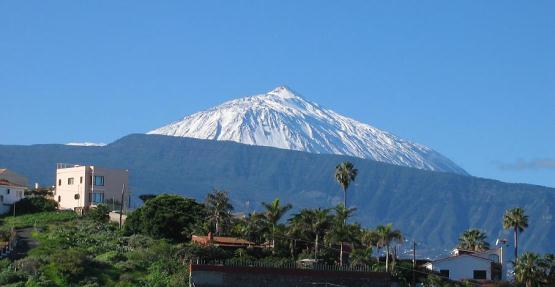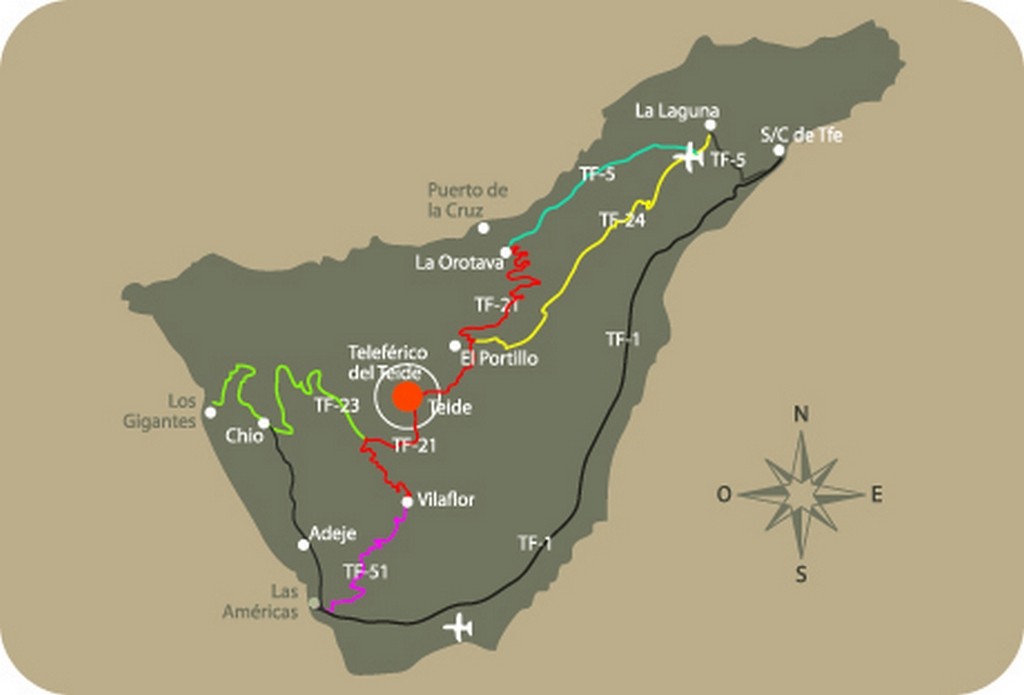Hiking mount Teide
Hiking some of the more than 30 trails on Teide is an absolute must for anyone who loves nature. The great variety and levels of difficulty make it easy for visitors to choose their ideal route. The trails with the most spectacular views are on the summit of Mount Teide and they can be reached on foot or by taking a comfortable ride in the cable car.
El Teide is a volcano on Tenerife in the Canary Islands. Its 3,718-metre (12,198 ft) high summit is the highest point in Spain, the highest point above sea level in the islands of the Atlantic, and it is the third highest volcano in the world measured from its base on the ocean floor (7,500 metres).

The volcano and its surroundings comprise the Teide National Park. The park has an area of 18,900 hectares (73 sq mi) and was named a World Heritage Site by UNESCO on June 29, 2007. Is also one of the most visited National Parks in the world, with a total of 2.8 million visitors, according to the Instituto Canario de Estadística.
Spring is the best time to visit Teide. Flowering broom and tajinaste blanket the vast landscape in an explosion of red and white. The weather is milder, just right for enjoying routes and trails. It is the perfect time for botany enthusiasts.
Winter snows cover the lava flows and badlands in a mantle of white. Large pools reflect a landscape of contrasts of extraordinary beauty. Many visitors are fortunate to catch a glimpse of the first snowfall.
Enjoying the sunrise from the Peak of Teide after having spent the night in the Altavista Mountain Refuge is one of those unique experiences everybody should have at least once in their lifetime.
Hiking Tenerife free maps
Hiking Routes Trails in Teide pdf 
Parque Nacional del Teide map pdf 
Teide is a tough mountain to climb involving up to 5 hours of high-altitude ascent. It is not suitable for people with heart or lung conditions or for pregnant women or young children.
How to reach the Teide Cable Car
The Teide Cable Car is located in the heart of Teide National Park, in Tenerife (Canary Islands). This cable car takes you on one of the most spectacular trips in Spain: straight up Mount Teide, the largest volcano in the country. As visitors travel up and down the mountain they will fly over an amazing geological treasure, where volcanos, craters and rivers of lava combine to create an impressive canvas of shapes and colours that cannot be found anywhere else in the world.
The Teide Cable Car is an aerial tramway with two passenger cabins attached to fixed track cables, each pulled by separate propulsion cables, so that while one cabin goes up, the other comes down. The trip covers a total of 2,471 m (a horizontal distance of 2,152 m), passing four towers, the first three from the bottom are 50 m tall and the final one is 25 m tall. The cable car travels at a speed of 8 m/s (29 Km/h), slowing down to 7 m/s when passing the towers.
The lower station is located on the TF-21 highway, at an altitude of 2,356 m. There are two modern passenger cabins each with a carrying capacity of 38 people and one leaves from this station every 8 minutes. The lower station has free parking, a rest area, café, store and buffet restaurant with magnificent views of Teide National Park.
The upper station has a small hall which leads the visitors to the outside. At an altitude of 3,555 m, the station is the starting point for the different activities offered by our ‘Volcano Life Experience’ programme, the perfect complement for an unforgettable day.
Teide cable car is very easy to get to by road. Depending on your starting point on the island, there are several ways to arrive quickly and easily.

How to reach the Teide Cable Car
From the north of the island
By car: Take the TF-21 highway that links La Orotava with Portillo de la Villa and crosses the entire national park; the Cable Car Station is located at km. 43 (N28º 15′ 17″ W16º 37′ 33″)
(Guagua) Tenerife Bus line 348 Puerto de La Cruz – Las Cañadas del Teide. Departure time: 09:15 h from Puerto de la Cruz, stopping at La Orotava, Montaña Blanca (for ascent to Altavista Refuge) and Teide Cable Car. Return from Teide Cable Car at 16:00 h.
From the south of the island
Take the TF-21 highway from Vilaflor to Teide National Park, access road for tourist resorts of Playa de Las Américas and Los Cristianos.
Take the TF-38 highway from Boca de Tauce to Chío, which links up with the TF-21.
(Guagua) Tenerife Bus Line 342 Playa de Las Américas – Las Cañadas del Teide. Departure time: 09:15 h from Las Américas, stopping at Los Cristianos (09:30 h), Teide Cable Car and Montaña Blanca (for ascent to Altavista Refuge).Return from Teide Cable Car at 15:30 h.
If you are near Santa Cruz or La Laguna
Take the TF-24 highway from La Laguna to Portillo de la Villa (La Esperanza Road), which joins the TF-21 that leads to the lower station at km. 43.
Distances:
- Santa Cruz de Tenerife: 64 Km
- La Laguna: 55 Km
- Puerto de la Cruz: 45 Km
- Los Gigantes: 52 Km
- Los Cristianos: 47 Km
- El Medano: 52 Km
Altavista del Teide High Mountain Refuge
The Altavista Refuge was originally used by scientists to observe stars. Today it is a unique spot in the world at an altitude of 3,265 m, equipped for hikers and visitors who wish to climb to the crater of the great volcano of Teide National Park. It is located halfway up the traditional trail leading to the summit of the Teide volcano. In fact, it is the lodging located at the highest altitude in Spain, the perfect spot to admire the exceptional quality of the night sky. Spending the night at the refuge allows you to experience the first rays of sun on the summit of Teide as they inundate the landscape with colours, while the volcano casts its protective shadow over the ocean.
Remember: Prevention, Information and Knowledge are the key to avoiding unpleasant situations.
- Make sure you always have somebody else to walk with, stick to the marked footpaths and respect the way of life, privacy and property of the local inhabitants.
- If you keep your noise levels down, you will discover just how much life there is all around you.
- Take any rubbish with you, even organic waste. This will help preserve the beauty of the scenery and prevent the proliferation of rodents in the area. Take special care with cigarette butts.
- Picking up plants, animals or other items from the environment may entail the loss of irreplaceable resources.
- The people who take care of these Protected Nature Areas would be very grateful if you let them know about any incidents you may have noticed on your walk.
- Remember that the Island’s environment is as unique as it is unpredictable. It must be enjoyed responsibly and sensibly. Take special care in natural areas and don’t forget that accidents can happen at any time.
- Pay attention to signs.
- Check the weather forecast? to make sure the conditions are suitable.
- Wear suitable clothing and footwear for hiking and always pack your mobile phone, sunscreen, a hat, a coat, a waterproof, enough food and plenty of water in your backpack.
- Let your family and/or friends know which route you will be taking and bear in mind how many daylight hours you will need to complete it.
You may also like:
- Adeje – Barranco del Infierno – Ifonche – Roque Imoque – Roque del Conde – Las Casas
- Adeje — Walk Tenerife
- Arona – Ifonche – Arona Circular
- Arona – Vilaflor
- Costa del Silencio – Tenerife Coastal Escapism
- La Caleta – Tenerife Life in the Raw
- Los Cristianos – Palm-Mar – Las Galletas
- Malpaís de Güímar 1
- Malpaís de Güímar 2
- Malpaís de Güímar 3
- Palm-Mar – Las Galletas
- Piramide de Arona – Playa Las Americas – Puerto Colon
- Playa de Las Americas – La Caleta
- Playa Paraiso – La Caleta
- PR-TF 43 Garachico – Chinyero Mountain
- PR-TF 71 Camino de Teresme
- PR-TF 71.1 Boca del Paso – La Quinta
- PR-TF 71.2 Camino de Ifonche
- PR-TF 72 Vilaflor – Paisaje Lunar – Vilaflor
- SL-TF 218 Roque del Conde
- SL-TF 60 Santiago del Teide – Arguayo (Almond Blossom Route)
- SL-TF 71 Camino de la Virgen
